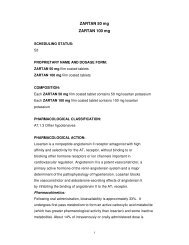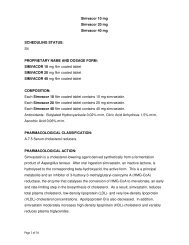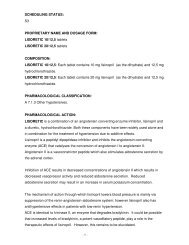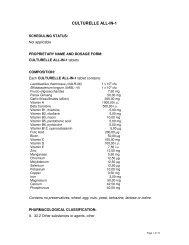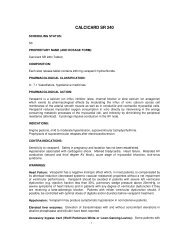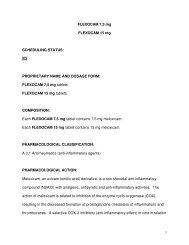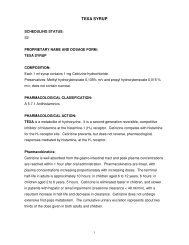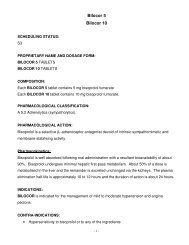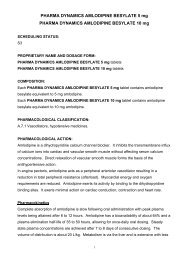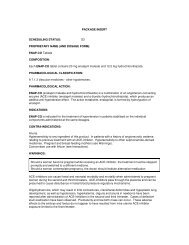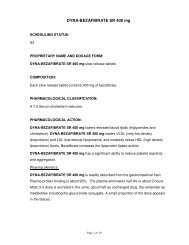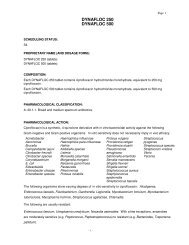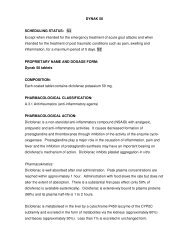PHARMA DYNAMICS CLOPIDOGREL 75 mg
PHARMA DYNAMICS CLOPIDOGREL 75 mg
PHARMA DYNAMICS CLOPIDOGREL 75 mg
You also want an ePaper? Increase the reach of your titles
YUMPU automatically turns print PDFs into web optimized ePapers that Google loves.
SCHEDULING STATUS: S3<br />
<strong>PHARMA</strong> <strong>DYNAMICS</strong> <strong>CLOPIDOGREL</strong> <strong>75</strong> <strong>mg</strong><br />
PROPRIETARY NAME AND DOSAGE FORM:<br />
<strong>PHARMA</strong> <strong>DYNAMICS</strong> Clopidogrel <strong>75</strong> <strong>mg</strong> film coated tablet<br />
COMPOSITION:<br />
Each film coated tablet contains clopidogrel bisulfate equivalent to <strong>75</strong> <strong>mg</strong> of clopidogrel.<br />
<strong>PHARMA</strong>COLOGICAL CLASSIFICATION:<br />
A 8.2 Anticoagulants.<br />
<strong>PHARMA</strong>COLOGICAL ACTION:<br />
Pharmacodynamics:<br />
Clopidogrel is a specific and potent inhibitor of platelet aggregation. It acts by irreversibly<br />
modifying the platelet ADP-receptors. It inhibits the binding of adenosine diphosphate<br />
(ADP) to its platelet receptor, and subsequent ADP-mediated activation of the glycoprotein<br />
GPIIb/llla complex, thereby inhibiting platelet aggregation. Consequently, platelets<br />
exposed to clopidogrel are affected for the remainder of their lifespan and recovery of<br />
normal platelet function occurs at a rate consistent with platelet turnover (of about 7 days).<br />
Clopidogrel also inhibits platelet aggregation induced by other agonists by blocking the<br />
amplification of platelet activation by released ADP.<br />
Biotransformation of clopidogrel is necessary to produce inhibition of platelet aggregation.<br />
Repeated doses of <strong>75</strong> <strong>mg</strong> per day may produce inhibition of ADP-induced platelet<br />
aggregation from the first day; this may increase progressively and reach steady state<br />
between Day 3 and Day 7. At steady state, the average inhibition level observed with a<br />
1
dose of <strong>75</strong> <strong>mg</strong> per day may be between 40% and 60%. Platelet aggregation and bleeding<br />
time gradually returns to baseline values, generally within 7 days after treatment has been<br />
discontinued.<br />
Pharmacokinetics<br />
After oral doses, clopidogrel is rapidly absorbed. Absorption is at least 50%. Clopidogrel is<br />
extensively metabolised by the liver and the main metabolite, which is inactive, is the<br />
carboxylic acid derivative which represents about 85% of the circulating compound in the<br />
plasma.<br />
Clopidogrel and the main metabolite bind, in vitro, reversibly to human plasma proteins<br />
(98% and 94% respectively).<br />
The elimination half-life of the main circulating metabolite may reach 8 hours after<br />
administration. Clopidogrel and the main metabolite are excreted in urine (50%) and<br />
faeces (46%).<br />
INDICATIONS:<br />
<strong>PHARMA</strong> <strong>DYNAMICS</strong> <strong>CLOPIDOGREL</strong> <strong>75</strong> <strong>mg</strong> is indicated for the following:<br />
• Reduction of atherosclerotic events (myocardial infarction, stroke, death due to<br />
vascular causes) in patients with a history of symptomatic atherosclerotic disease<br />
defined by ischaemic stroke (from 7 days until less than 6 months), myocardial<br />
infarction (from a few days until less than 35 days) or established peripheral arterial<br />
disease.<br />
CONTRA-INDICATIONS:<br />
<strong>PHARMA</strong> <strong>DYNAMICS</strong> <strong>CLOPIDOGREL</strong> <strong>75</strong> <strong>mg</strong> is contra-indicated in:<br />
• Hypersensitivity to the active substance or any component of the product.<br />
• Active bleeding such as peptic ulcer and intracranial haemorrhage.<br />
• Safety and efficacy in patients below the age of 18 have not been established.<br />
2
• Pregnancy and lactation.<br />
• Severe liver impairment.<br />
• Thrombocytopenia.<br />
• Platelet dysfunction.<br />
WARNINGS:<br />
THROMBOTIC THROMBOCYTOPENIC PURPURA (TTP) HAS BEEN REPORTED TO<br />
OCCUR WITH <strong>PHARMA</strong> <strong>DYNAMICS</strong> <strong>CLOPIDOGREL</strong> <strong>75</strong> <strong>mg</strong> DURING POST-<br />
MARKETING EXPERIENCE. MOST CASES WERE REPORTED IN THE FIRST TWO<br />
WEEKS OF TREATMENT. IN ADDITION, PRESCRIBERS SHOULD WARN PATIENTS<br />
ABOUT THE SIGNS AND SYMPTOMS OF THROMBOTIC THROMBOCYTOPENIC<br />
PURPURA (TTP).<br />
The clinical diagnosis of TTP is characterized by the presence of thrombocytopenia,<br />
haemolytic anaemia, neurological symptoms, renal dysfunction and fever.<br />
Due to the risk of fatal outcome, in the event of suspected thrombotic thrombocytopenic<br />
purpura, <strong>PHARMA</strong> <strong>DYNAMICS</strong> <strong>CLOPIDOGREL</strong> <strong>75</strong> <strong>mg</strong> should be stopped. The<br />
management of a patient with thrombotic thrombocytopenic purpura is complex. Early<br />
treatment with plasmapharesis is indicated in TTP.<br />
• Risk of increased blood loss during dental and surgical procedures.<br />
• Active bleeding such as peptic ulcer and intracranial haemorrhage.<br />
• Use with caution in patients receiving other medicines that increase the risk of<br />
bleeding (anticoagulants, NSAIDs and other anticoagulants).<br />
INTERACTIONS:<br />
3
Acetylsalicylic acid (aspirin):<br />
<strong>PHARMA</strong> <strong>DYNAMICS</strong> <strong>CLOPIDOGREL</strong> <strong>75</strong> <strong>mg</strong> potentiates the effects of acetylsalicylic<br />
acid on collagen-induced platelet aggregation. A pharmacodynamic interaction between<br />
clopidogrel and acetylsalicylic acid (aspirin) is possible, leading to increased risk of<br />
bleeding. Therefore, concomitant use should be undertaken with caution. The safety of the<br />
chronic concomitant administration of acetylsalicylic acid (aspirin) and <strong>PHARMA</strong><br />
<strong>DYNAMICS</strong> <strong>CLOPIDOGREL</strong> <strong>75</strong> <strong>mg</strong> has not been established (see Special Precautions).<br />
Heparin:<br />
The safety of this combination has not been established and concomitant use should be<br />
undertaken with caution. A pharmacodynamic interaction between clopidogrel and heparin<br />
is possible, leading to increased risk of bleeding.<br />
Thrombolytics:<br />
The safety of the concomitant administration of <strong>PHARMA</strong> <strong>DYNAMICS</strong> <strong>CLOPIDOGREL</strong> <strong>75</strong><br />
<strong>mg</strong> with other thrombolytic agents has not been established and should be undertaken<br />
with caution.<br />
Warfarin:<br />
The safety of the co-administration of <strong>PHARMA</strong> <strong>DYNAMICS</strong> <strong>CLOPIDOGREL</strong> <strong>75</strong> <strong>mg</strong><br />
with warfarin has not been established. Consequently, concomitant administration of<br />
these two agents should be undertaken with caution.<br />
Non-Steroidal Anti-Inflammatory Agents (NSAIDs) including aspirin:<br />
There is a potential risk of gastrointestinal bleeding and NSAIDs, including aspirin, and<br />
<strong>PHARMA</strong> <strong>DYNAMICS</strong> <strong>CLOPIDOGREL</strong> <strong>75</strong> <strong>mg</strong> should be co-administered with caution<br />
(see Special Precautions). NSAIDs, including COX-2 inhibitors, and clopidogrel should<br />
be co-administered with caution.<br />
Glycoprotein llb/llla inhibitors:<br />
<strong>PHARMA</strong> <strong>DYNAMICS</strong> <strong>CLOPIDOGREL</strong> <strong>75</strong> <strong>mg</strong> should be used with caution in patients<br />
who may be at risk of increased bleeding from trauma, surgery or other<br />
4
conditions/disorders that may require concomitant glycoprotein llb/llla inhibitors intake.<br />
Other concomitant therapy:<br />
No clinically significant pharmacodynamic interactions were observed when <strong>PHARMA</strong><br />
<strong>DYNAMICS</strong> <strong>CLOPIDOGREL</strong> <strong>75</strong> <strong>mg</strong> was co-administered with atenolol, nifedipine, or both<br />
atenolol and nifedipine. The pharmacodynamic activity of <strong>PHARMA</strong> <strong>DYNAMICS</strong><br />
<strong>CLOPIDOGREL</strong> <strong>75</strong> <strong>mg</strong> was not significantly influenced by the co-administration of<br />
phenobarbital, cimetidine, or oestrogen. The pharmacokinetics of digoxin or theophylline<br />
were not modified by the co-administration of <strong>PHARMA</strong> <strong>DYNAMICS</strong> <strong>CLOPIDOGREL</strong> <strong>75</strong><br />
<strong>mg</strong>. <strong>PHARMA</strong> <strong>DYNAMICS</strong> <strong>CLOPIDOGREL</strong> <strong>75</strong> <strong>mg</strong> inhibits the activity of cytochrome P450<br />
enzyme: CYP2C9. This leads to increased plasma levels of medicines such as phenytoin,<br />
tolbutamide, warfarin, tamoxifen, fluvastatin and many NSAIDs which are metabolized by<br />
CYP2C9.<br />
PREGNANCY AND LACTATION:<br />
The use of <strong>PHARMA</strong> <strong>DYNAMICS</strong> <strong>CLOPIDOGREL</strong> <strong>75</strong> <strong>mg</strong> during pregnancy and lactation<br />
is not recommended as safety and efficacy have not been established (see CONTRA-<br />
INDICATIONS).<br />
DOSAGE AND DIRECTIONS FOR USE:<br />
Adults:<br />
<strong>PHARMA</strong> <strong>DYNAMICS</strong> <strong>CLOPIDOGREL</strong> <strong>75</strong> <strong>mg</strong> should be given as a single daily dose of<br />
<strong>75</strong> <strong>mg</strong>, with or without food.<br />
SIDE-EFFECTS AND SPECIAL PRECAUTIONS:<br />
Side- Effects:<br />
Blood and lymphatic system disorders:<br />
Frequent: Purpura, haematoma.<br />
5
Less frequent: Epistaxis, gastrointestinal haemorrhage, intracranial haemorrhage, severe<br />
neutropenia (including agranulocytosis), severe thrombocytopenia<br />
(including thrombotic thrombocytopenic purpura)<br />
The following has been reported but the frequency is unknown:<br />
Bruising, haematuria, ocular bleeding (mainly conjunctival, but also ocular and retinal),<br />
respiratory tract bleeding and aplastic anaemia (pancytopenia), musculoskeletal bleeding<br />
(including haemathrosis), haemorrhagic ulcer, haemothorax, haemorrhage of operative<br />
wound and retroperitoneal haemorrhage, serum sickness.<br />
Gastro-intestinal disorders:<br />
Frequent: Abdominal pain, dyspepsia.<br />
Less frequent: Gastrointestinal haemorrhage, diarrhoea, nausea, constipation, vomiting,<br />
peptic, gastric or duodenal ulcer.<br />
The following has been reported but the frequency is unknown:<br />
Flatulence, gastritis.<br />
Skin and subcutaneous tissue disorders:<br />
Less frequent: Rash, severe skin reactions (including bullous eruption)<br />
The following has been reported but the frequency is unknown:<br />
Pruritus, erythema multiforme, Stevens-Johnson syndrome, toxic epidermal necrolysis,<br />
lichen planus, urticaria, eczema<br />
Nervous system disorders:<br />
Frequent: Headache, dizziness.<br />
Less frequent: Paraesthesia, intracranial bleeding, syncope, anxiety, hypoaesthesia,<br />
insomnia, mental depression.<br />
The following has been reported but the frequency is unknown:<br />
6
Vertigo, confusion, hallucinations, taste disorders.<br />
Cardiac disorders:<br />
Frequent: Chest pain.<br />
Less frequent: Atrial fibrillation or palpitations, oedema, hypertension.<br />
The following has been reported but the frequency is unknown:<br />
Hypotension, vasculitis.<br />
Respiratory, thoracic and mediastinal disorders:<br />
Frequent: Upper respiratory tract infections.<br />
Less frequent: Bronchitis, dyspnoea, cough, rhinitis.<br />
The following has been reported but the frequency is unknown:<br />
Interstitial pneumonitis.<br />
Hepatobiliary disorders:<br />
The following has been reported but the frequency is unknown:<br />
Abnormal liver function tests, hepatitis, acute liver failure.<br />
Renal and urinary disorders:<br />
Less frequent: Urinary tract infection.<br />
The following has been reported but the frequency is unknown:<br />
Glomerulopathy, increased creatinine levels.<br />
Musculoskeletal, connective tissue and bone disorders:<br />
Frequent: Arthralgia, back pain.<br />
Less frequent: Gout, leg cramps.<br />
7
The following has been reported but the frequency is unknown:<br />
Myalgia, arthritis.<br />
Other:<br />
Frequent: Generalised pain, flu-like symptoms<br />
Less frequent: Fatigue, asthenia, oedema, itching, tooth disorder.<br />
The following has been reported but the frequency is unknown:<br />
Hypersensitivity reactions such as bronchospasm, angioedema or anaphylactoid<br />
reactions.<br />
Special Precautions:<br />
<strong>PHARMA</strong> <strong>DYNAMICS</strong> <strong>CLOPIDOGREL</strong> <strong>75</strong> <strong>mg</strong> should be used with caution in patients<br />
who may be at risk of increased bleeding from trauma, surgery or other pathological<br />
conditions and in patients receiving treatment with acetylsalicylic acid (aspirin), NSAIDs<br />
(including COX-2 inhibitors), heparin or glycoprotein llb/llla inhibitors. Patients should be<br />
monitored carefully for any signs of bleeding, including occult bleeding, especially during<br />
the first week of treatment and/or after invasive cardiac procedures or surgery. The<br />
concomitant administration of clopidogrel with warfarin is not recommended since it may<br />
increase the intensity of bleedings. If a patient is to undergo elective surgery and an anti-<br />
platelet effect is not desired, <strong>PHARMA</strong> <strong>DYNAMICS</strong> <strong>CLOPIDOGREL</strong> <strong>75</strong> <strong>mg</strong> should be<br />
discontinued 7 days prior to surgery.<br />
<strong>PHARMA</strong> <strong>DYNAMICS</strong> <strong>CLOPIDOGREL</strong> <strong>75</strong> <strong>mg</strong> prolongs bleeding time and should be used<br />
with caution in patients who have lesions with a propensity to bleed such as<br />
gastrointestinal ulcers and intra-ocular bleeding. Medicines that might induce lesions (such<br />
as acetylsalicylic acid and NSAIDs should be used with caution in patients taking<br />
<strong>PHARMA</strong> <strong>DYNAMICS</strong> <strong>CLOPIDOGREL</strong> <strong>75</strong> <strong>mg</strong>.<br />
Patients should be told that it may take longer than usual to stop bleeding when they take<br />
8
<strong>PHARMA</strong> <strong>DYNAMICS</strong> <strong>CLOPIDOGREL</strong> <strong>75</strong> <strong>mg</strong>, and that they should report any unusual<br />
bleeding to their medical practitioner. Patients should inform medical practitioners and<br />
dentists that they are taking <strong>PHARMA</strong> <strong>DYNAMICS</strong> <strong>CLOPIDOGREL</strong> <strong>75</strong> <strong>mg</strong> before any<br />
surgery is scheduled and before any new medicine is taken. In view of the possible<br />
increased risk of bleeding, the concomitant administration of <strong>PHARMA</strong> <strong>DYNAMICS</strong><br />
<strong>CLOPIDOGREL</strong> <strong>75</strong> <strong>mg</strong> with acetylsalicylic acid, heparin, warfarin or thrombolytics should<br />
be undertaken with caution (see INTERACTIONS).<br />
In patients with recent transient ischaemic attack (TIA) or stroke, who are at high risk of<br />
recurrent ischaemic events, the combination of aspirin and <strong>PHARMA</strong> <strong>DYNAMICS</strong><br />
<strong>CLOPIDOGREL</strong> <strong>75</strong> <strong>mg</strong> has not been shown to be more effective than <strong>PHARMA</strong><br />
<strong>DYNAMICS</strong> <strong>CLOPIDOGREL</strong> <strong>75</strong> <strong>mg</strong> alone, but the combination has been shown to<br />
increase major bleeding. It is therefore recommended that such addition should be<br />
undertaken with caution. In patients with acute myocardial infarction, <strong>PHARMA</strong><br />
<strong>DYNAMICS</strong> <strong>CLOPIDOGREL</strong> <strong>75</strong> <strong>mg</strong> therapy should not be initiated within the first few<br />
days following myocardial infarction. In view of the lack of data, <strong>PHARMA</strong> <strong>DYNAMICS</strong><br />
<strong>CLOPIDOGREL</strong> <strong>75</strong> <strong>mg</strong> cannot be recommended in coronary artery bypass graft (CABG)<br />
and acute ischaemic stroke (less than 7 days). Clinical experience is limited in patients<br />
with renal impairment and moderate hepatic disease with bleeding diatheses, <strong>PHARMA</strong><br />
<strong>DYNAMICS</strong> <strong>CLOPIDOGREL</strong> <strong>75</strong> <strong>mg</strong> should be used with caution in these patients.<br />
Thrombocytopenia, neutropenia, aplastic anaemia and pancytopenia have been reported<br />
in patients taking clopidogrel (see SIDE-EFFECTS).<br />
Effects on ability to drive and use machines:<br />
No impairment of driving or psychometric performance was observed following <strong>PHARMA</strong><br />
<strong>DYNAMICS</strong> <strong>CLOPIDOGREL</strong> <strong>75</strong> <strong>mg</strong> administration.<br />
KNOWN SYMPTOMS OF OVERDOSAGE AND PARTICULARS OF ITS TREATMENT:<br />
9
(See SIDE-EFFECTS AND SPECIAL PRECAUTIONS)<br />
Overdose following <strong>PHARMA</strong> <strong>DYNAMICS</strong> <strong>CLOPIDOGREL</strong> <strong>75</strong> <strong>mg</strong> administration may<br />
lead to prolonged bleeding time and subsequent bleeding complications.<br />
Treatment is symptomatic and supportive.<br />
IDENTIFICATION:<br />
Pink, round, slightly biconvex, film-coated tablets.<br />
PRESENTATION:<br />
<strong>PHARMA</strong> <strong>DYNAMICS</strong> <strong>CLOPIDOGREL</strong> <strong>75</strong> <strong>mg</strong> tablets are packed in OPA/AL/PVC film<br />
and heat sealing aluminium blister strips. Each strip contains ten tablets. The blister strips<br />
are packed in an outer carton in packs of 30s.<br />
STORAGE INSTRUCTIONS:<br />
Store at or below 25 °C.<br />
KEEP OUT OF REACH OF CHILDREN<br />
REGISTRATION NUMBER:<br />
42/8.2/0128<br />
NAME AND BUSINESS ADDRESS OF THE HOLDER OF THE REGISTRATION<br />
CERTIFICATE:<br />
Pharma Dynamics (Pty) Ltd.<br />
F02 Grapevine House<br />
Steenberg Office Park<br />
Westlake<br />
7945<br />
10
DATE OF PUBLICATION OF THIS PACKAGE INSERT<br />
October 2008<br />
11
SKEDULERINGSTATUS: S3<br />
<strong>PHARMA</strong> <strong>DYNAMICS</strong> <strong>CLOPIDOGREL</strong> <strong>75</strong> <strong>mg</strong><br />
EIENDOMSNAAM EN DOSEERVORM:<br />
<strong>PHARMA</strong> <strong>DYNAMICS</strong> Clopidogrel <strong>75</strong> <strong>mg</strong> filmbedekte tablet<br />
SAMESTELLING:<br />
Elke filmbedekte tablet bevat klopidogrelbisulfaat ekwivalent aan <strong>75</strong> <strong>mg</strong> klopidogrel.<br />
FARMAKOLOGIESE KLASSIFIKASIE:<br />
A 8.2 Antikoagulante.<br />
FARMAKOLOGIESE WERKING:<br />
Farmakodinamika:<br />
Klopidogrel is ‘n spesifieke en potente inhibeerder van plaatjie-aggregasie. Dit werk deur<br />
die plaatjie-ADP-reseptore onomkeerbaar te modifiseer. Dit inhibeer die binding van<br />
adenosiendifosfaat (ADP) aan sy plaatjiereseptor, en daaropvolgende ADP-bemiddelde<br />
aktivering van die glikoproteïen GPIIb/IIIa-kompleks, waardeur plaatjie-aggregasie<br />
geïnhibeer word. Plaatjies wat dus aan klopidogrel blootgestel word, word vir die res van<br />
hul lewensloop geaffekteer en herstel van normale plaatjiefunksie vind teen ‘n tempo wat<br />
ooreenstem met plaatjie-omset (ongeveer 7 dae), plaas. Klopidogrel inhibeer ook plaatjie-<br />
aggregasie wat deur ander agoniste geïnduseer word deur blokkering van die versterking<br />
van plaatjie-aktivering deur vrygestelde ADP.<br />
Biotransformasie van klopidogrel is noodsaaklik om inhibisie van plaatjie-aggregasie te<br />
veroorsaak. Herhaalde dosisse van <strong>75</strong> <strong>mg</strong> per dag mag inhibisie van ADP-geïnduseerde<br />
plaatjie-aggregasie vanaf die eerste dag produseer; dit mag progressief toeneem en die<br />
12
ewewigstoestand word tussen dag 3 en dag 7 bereik. In die ewewigstoestand mag die<br />
gemiddelde vlak van inhibisie wat met ‘n dosis van <strong>75</strong> <strong>mg</strong> per dag waargeneem word,<br />
wissel tussen 40% en 60%. Plaatjie-aggregasie en bloeityd keer geleidelik terug na<br />
basislynwaardes, meestal binne 7 dae nadat behandeling gestaak word.<br />
Farmakokinetika:<br />
Na orale dosisse, word klopidogrel vinnig geabsorbeer. Absorpsie is ten minste 50%.<br />
Klopidogrel word ekstensief deur die lewer gemetaboliseer en die hoofmetaboliet, wat<br />
onaktief is, is die karboksielsuurderivaat wat ongeveer 85% van die sirkulerende<br />
verbinding in die plasma verteenwoordig.<br />
Klopidogrel en die hoofmetaboliet bind in vitro omkeerbaar aan menslike plasmaproteïene<br />
(98% en 94% onderskeidelik).<br />
Die eliminasie halfleeftyd van die hoof sirkulerende metaboliet mag tot 8 uur na toediening<br />
duur. Klopidogrel en die hoofmetaboliet word in die urine (50%) en faeces (46%) uitgeskei.<br />
INDIKASIES:<br />
<strong>PHARMA</strong> <strong>DYNAMICS</strong> <strong>CLOPIDOGREL</strong> <strong>75</strong> <strong>mg</strong> word aangedui vir die volgende:<br />
• Vermindering van aterosklerotiese insidente (miokardiale infarksie, beroerte, sterfte as<br />
gevolg van vaskulêre oorsake) in pasiënte met ‘n geskiedenis van simptomatiese<br />
aterosklerotiese siekte gedefinieer deur iskemiese beroerte (van 7 dae tot minder as 6<br />
maande), miokardiale infarksie (van ‘n paar dae tot minder as 35 dae) of gevestigde<br />
perifere arteriële siekte.<br />
KONTRA-INDIKASIES:<br />
<strong>PHARMA</strong> <strong>DYNAMICS</strong> <strong>CLOPIDOGREL</strong> <strong>75</strong> <strong>mg</strong> word teenaangedui in:<br />
• Hipersensitiwiteit teenoor die aktiewe stof of enige komponent van die produk.<br />
• Aktiewe bloeding soos peptiese ulkusse en intrakraniale bloeding.<br />
13
• Veiligheid en doeltreffendheid in pasiënte onder die ouderdom van 18 is nie vasgestel<br />
nie.<br />
• Swangerskap en laktasie.<br />
• Ernstige lewerinkorting.<br />
• Trombositopenie.<br />
• Plaatjiedisfunksie.<br />
WAARSKUWINGS:<br />
DAAR IS GERAPPORTEER DAT TROMBOTIESE TROMBOSITOPENIESE<br />
PURPURA (TTP) MET <strong>PHARMA</strong> <strong>DYNAMICS</strong> <strong>CLOPIDOGREL</strong> <strong>75</strong> <strong>mg</strong> TYDENS<br />
NABEMARKINGSONDERVINDING, VOORGEKOM HET. DIE MEESTE<br />
GEVALLE IS IN DIE EERSTE TWEE WEKE VAN BEHANDELING<br />
GERAPPORTEER. DAARBENEWENS, BEHOORT VOORSKRYWENDE<br />
GENEESHERE PASIËNTE TE WAARSKU OOR DIE TEKENS EN SIMPTOME<br />
VAN TROMBOTIESE TROMBOSITOPENIESE PURPURA (TTP).<br />
Die kliniese diagnose van TTP word gekenmerk deur die teenwoordigheid van<br />
trombositopenie, hemolitiese anemie, neurologiese simptome, nierdisfunksie en koors.<br />
As gevolg van die risiko van dood behoort <strong>PHARMA</strong> <strong>DYNAMICS</strong> <strong>CLOPIDOGREL</strong> <strong>75</strong> <strong>mg</strong><br />
gestaak te word wanneer trombotiese trombositopeniese purpura vermoed word Die<br />
hantering van ‘n pasiënt met trombotiese trombositopeniese purpura is ingewikkeld. Vroeë<br />
behandeling met plasmafarese word in TTP aangedui.<br />
• Risiko van verhoogde bloedverlies tydens tandheelkundige en chirurgiese prosedures.<br />
• Aktiewe bloeding soos peptiese ulkusse en intrakraniale bloeding.<br />
• Gebruik met omsigtigheid in pasiënte wat ander medisyne ontvang wat die risiko van<br />
bloeding verhoog (antikoagulante, NSAIMs en ander antikoagulante).<br />
14
INTERAKSIES:<br />
Asetielsalisielsuur (aspirien):<br />
<strong>PHARMA</strong> <strong>DYNAMICS</strong> <strong>CLOPIDOGREL</strong> <strong>75</strong> <strong>mg</strong> versterk die effekte van asetielsalisielsuur<br />
op kollageen-geïnduseerde plaatjie-aggregasie. ‘n Farmakodinamiese interaksie tussen<br />
klopidogrel en asetielsalisielsuur (aspirien) is moontlik, wat kan lei tot verhoogde risiko van<br />
bloeding. Gelyktydige gebruik moet dus met omsigtigheid onderneem word. Die veiligheid<br />
van die chroniese gelyktydige toediening van asetielsalisielsuur (aspirien) en <strong>PHARMA</strong><br />
<strong>DYNAMICS</strong> <strong>CLOPIDOGREL</strong> <strong>75</strong> <strong>mg</strong> is nie vasgestel nie (sien Spesiale<br />
Voorsorgmaatreëls).<br />
Heparien:<br />
Die veiligheid van hierdie kombinasie is nie vasgestel nie en gelyktydige gebruik moet dus<br />
met omsigtigheid onderneem word.‘n Farmakodinamiese interaksie tussen klopidogrel en<br />
heparien is moontlik, wat kan lei tot verhoogde risiko van bloeding.<br />
Trombolitiese middels:<br />
Die veiligheid van die gelyktydige toediening van <strong>PHARMA</strong> <strong>DYNAMICS</strong> <strong>CLOPIDOGREL</strong><br />
<strong>75</strong> <strong>mg</strong> saam met ander trombolitiese middels is nog nie vasgestel nie en behoort met<br />
omsigtigheid onderneem te word.<br />
Warfarien:<br />
Die veiligheid van die gelyktydige toediening van <strong>PHARMA</strong> <strong>DYNAMICS</strong> <strong>CLOPIDOGREL</strong><br />
<strong>75</strong> <strong>mg</strong> met warfarien is nie vasgestel nie. Gevolglik behoort gelyktydige toediening van<br />
hierdie twee middels met omsigtigheid plaas te vind.<br />
Nie-Steroïedale Anti-Inflammatoriese Middels (NSAIMs) insluitend aspirien:<br />
Daar bestaan ‘n potensiële risiko van gastroïntestinale bloeding en gelyktydige toediening<br />
15
van NSAIMs, insluitend aspirien, en <strong>PHARMA</strong> <strong>DYNAMICS</strong> <strong>CLOPIDOGREL</strong> <strong>75</strong> <strong>mg</strong><br />
behoort met omsigtigheid plaas te vind (sien Spesiale Voorsorgmaatreëls). NSAIMs,<br />
insluitend KOKS-2-inhibeerders, en klopidogrel behoort slegs met omsigtigheid saam<br />
toegedien te word.<br />
Glikoproteïen IIb/IIIa-inhibeerders:<br />
<strong>PHARMA</strong> <strong>DYNAMICS</strong> <strong>CLOPIDOGREL</strong> <strong>75</strong> <strong>mg</strong> behoort met omsigtigheid gebruik te word<br />
in pasiënte wat blootgestel is aan die risiko van verhoogde bloeding van trauma, chirurgie<br />
of ander toestande/versteurings wat gelyktydige inname van glikoproteïen IIb/IIIa-<br />
inhibeerders mag benodig.<br />
Ander gelyktydige terapie:<br />
Geen klinies beduidende farmakodinamiese interaksies is waargeneem toe <strong>PHARMA</strong><br />
<strong>DYNAMICS</strong> <strong>CLOPIDOGREL</strong> <strong>75</strong> <strong>mg</strong> saam met atenolol, nifedipien, of beide atenolol en<br />
nifedipien, toegedien is nie. Die farmakodinamiese aktiwiteit van <strong>PHARMA</strong> <strong>DYNAMICS</strong><br />
<strong>CLOPIDOGREL</strong> <strong>75</strong> <strong>mg</strong> is nie beduidend deur die gelyktydige toediening van fenobarbital,<br />
simetidien, of estrogeen beïnvloed nie.<br />
Die farmakokinetika van digoksien of teofillien is nie deur die gelyktydige toediening van<br />
<strong>PHARMA</strong> <strong>DYNAMICS</strong> <strong>CLOPIDOGREL</strong> <strong>75</strong> <strong>mg</strong> gemodifiseer nie. <strong>PHARMA</strong> <strong>DYNAMICS</strong><br />
<strong>CLOPIDOGREL</strong> <strong>75</strong> <strong>mg</strong> inhibeer die aktiwiteit van die sitochroom P450 ensiem: CYP2C9.<br />
Dit lei tot verhoogde plasmavlakke van medisyne soos fenitoïen, tolbutamied, warfarien,<br />
tamoksifen, fluvastatien en baie NSAIMs wat deur CYP2C9 gemetaboliseer word.<br />
SWANGERSKAP EN LAKTASIE:<br />
Die gebruik van <strong>PHARMA</strong> <strong>DYNAMICS</strong> <strong>CLOPIDOGREL</strong> <strong>75</strong> <strong>mg</strong> tydens swangerskap en<br />
laktasie word nie aanbeveel omdat veiligheid en doeltreffendheid nie vasgestel is nie (sien<br />
KONTRA-INDIKASIES).<br />
16
DOSIS EN GEBRUIKSAANWYSINGS:<br />
Volwassenes:<br />
<strong>PHARMA</strong> <strong>DYNAMICS</strong> <strong>CLOPIDOGREL</strong> <strong>75</strong> <strong>mg</strong> behoort as ‘n enkele daaglikse dosis van<br />
<strong>75</strong> <strong>mg</strong>, met of sonder kos, gegee te word.<br />
NEWE-EFFEKTE EN SPESIALE VOORSORGMAATREËLS:<br />
Newe-effekte:<br />
Bloed- en limfatiese sisteemversteurings:<br />
Frekwent: Purpura, hematoom.<br />
Minder frekwent: Neusbloeding, gastroïntestinale bloeding, intrakraniale bloeding,<br />
ernstige neutropenie (insluitend agranulositose), ernstige<br />
trombositopenie (insluitend trombotiese trombositopeniese purpura)<br />
Die volgende is aangemeld, maar die frekwensie is onbekend:<br />
Kneusing, hematurie, okulêre bloeding (hoofsaaklik van die konjunktiva, maar ook okulêr<br />
en retinaal), bloeding van die lugweg en aplastiese anemie (pansitopenie),<br />
muskuloskeletale bloeding (insluitend hemartrose), hemoragiese ulkus, hemotoraks,<br />
bloeding van die operasiewond en retroperitoneale bloeding, serumsiekte.<br />
Gastroïntestinale versteurings:<br />
Frekwent: Abdominale pyn, dispepsie.<br />
Minder frekwent: Gastroïntestinale bloeding, diarree, naarheid, hardlywigheid, braking,<br />
peptiese, gastriese of duodenale ulkus.<br />
Die volgende is aangemeld, maar die frekwensie is onbekend:<br />
17
Winderigheid, gastritis.<br />
Vel- en onderhuidse weefselversteurings:<br />
Minder frekwent: Veluitslag, ernstige velreaksies (insluitend bulleuse erupsie)<br />
Die volgende is aangemeld, maar die frekwensie is onbekend:<br />
Pruritus, erythema multiforme, Stevens-Johnson-sindroom, toksiese epidermale nekrolise,<br />
lichen planus, urtikarie, ekseem.<br />
Senusisteemversteurings:<br />
Frekwent: Hoofpyn, duiseligheid.<br />
Minder frekwent: Parestesie, intrakraniale bloeding, sinkopee, angs, hipoëstesie,<br />
slaaploosheid, geestesdepressie.<br />
Die volgende is aangemeld, maar die frekwensie is onbekend:<br />
Vertigo, verwarring, hallusinasies, smaakversteurings.<br />
Kardiale versteurings:<br />
Frekwent: Borspyn.<br />
Minder frekwent: Atriale fibrillasie of hartkloppings, edeem, hipertensie.<br />
Die volgende is aangemeld, maar die frekwensie is onbekend:<br />
Hipotensie, vaskulitis.<br />
Respiratoriese, torakale en mediastinale versteurings:<br />
Frekwent: Infeksies van die boonste lugweg.<br />
Minder frekwent: Brongitis, dispnee, hoes, rinitis.<br />
18
Die volgende is aangemeld, maar die frekwensie is onbekend:<br />
Interstisiële pneumonitis.<br />
Hepatobiliêre versteurings:<br />
Die volgende is aangemeld, maar die frekwensie is onbekend:<br />
Abnormale lewerfunksietoetse, hepatitis, akute lewerversaking.<br />
Renale en urinêre versteurings:<br />
Minder frekwent: Urienweginfeksie.<br />
Die volgende is aangemeld, maar die frekwensie is onbekend:<br />
Glomerulopatie, verhoogde kreatinienvlakke.<br />
Muskuloskeletale, bindweefsel- en beenversteurings:<br />
Frekwent: Artralgie, rugpyn.<br />
Minder frekwent: Jig, beenkrampe.<br />
Die volgende is aangemeld, maar die frekwensie is onbekend:<br />
Mialgie, artritis.<br />
Ander:<br />
Frekwent: Veralgemeende pyn, griepagtige simptome.<br />
Minder frekwent: Moegheid, astenie, edeem, jeuk, tandversteuring<br />
Die volgende is aangemeld, maar die frekwensie is onbekend:<br />
Hipersensitiwiteitsreaksies soos brongospasma, angio-edeem of anafilaktoïede reaksies.<br />
19
Spesiale Voorsorgmaatreëls:<br />
<strong>PHARMA</strong> <strong>DYNAMICS</strong> <strong>CLOPIDOGREL</strong> <strong>75</strong> <strong>mg</strong> behoort moet omsigtigheid gebruik te word<br />
by pasiënte wat aan die risiko van verhoogde bloeding van trauma, chirurgie of ander<br />
patologiese toestande blootgestel is en in pasiënte wat behandeling ontvang met<br />
asetielsalisielsuur (aspirien), NSAIMs (insluitend KOKS-2-inhibeerders), heparien of<br />
glikoproteïen IIb/IIIa-inhibeerders. Pasiënte behoort versigtig gemoniteer te word vir enige<br />
tekens van bloeding, insluitend okkulte bloeding, veral tydens die eerste week van<br />
behandeling en/of na indringende kardiale prosedures of chirurgie. Die gelyktydige<br />
toediening van klopidogrel saam met warfarien word nie aanbeveel nie aangesien dit die<br />
intensiteit van bloedings mag verhoog. Indien ‘n pasiënt elektiewe chirurgie moet<br />
ondergaan en ‘n antiplaatjie-effek nie wenslik is nie, behoort <strong>PHARMA</strong> <strong>DYNAMICS</strong><br />
<strong>CLOPIDOGREL</strong> <strong>75</strong> <strong>mg</strong> 7 dae voor chirurgie gestaak te word. <strong>PHARMA</strong> <strong>DYNAMICS</strong><br />
<strong>CLOPIDOGREL</strong> <strong>75</strong> <strong>mg</strong> verleng bloeityd en behoort met omsigtigheid gebruik te word in<br />
pasiënte wat letsels het wat geneig is om te bloei soos gastroïntestinale ulkusse en intra-<br />
okulêre bloeding. Medisyne wat letsels mag induseer (soos asetielsalisielsuur en NSAIMs)<br />
behoort met omsigtigheid gebruik te word in pasiënte wat <strong>PHARMA</strong> <strong>DYNAMICS</strong><br />
<strong>CLOPIDOGREL</strong> <strong>75</strong> <strong>mg</strong> neem. Pasiënte moet ingelig word dat dit langer as gewoonlik<br />
mag neem om bloeding te stop wanneer hulle <strong>PHARMA</strong> <strong>DYNAMICS</strong> <strong>CLOPIDOGREL</strong> <strong>75</strong><br />
<strong>mg</strong> neem, en dat hulle enige ongewone bloeding aan hulle mediese praktisyn moet<br />
rapporteer. Pasiënte moet mediese praktisyns en tandartse inlig dat hulle <strong>PHARMA</strong><br />
<strong>DYNAMICS</strong> <strong>CLOPIDOGREL</strong> <strong>75</strong> <strong>mg</strong> neem voordat enige chirurgie geskeduleer word en<br />
voordat enige nuwe medisyne geneem word. Met inagneming van die moontlike<br />
verhoogde risiko van bloeding, behoort die gelyktydige toediening van <strong>PHARMA</strong><br />
<strong>DYNAMICS</strong> <strong>CLOPIDOGREL</strong> <strong>75</strong> <strong>mg</strong> saam met asetielsalisielsuur, heparien, warfarien of<br />
trombolitiese middels, met omsigtigheid plaas te vind (sien INTERAKSIES).<br />
20
By pasiënte met ‘n onlangse verbygaande iskemiese aanval (VIA) of beroerte, wat aan ‘n<br />
hoë risiko van herhaalde iskemiese insidente blootgestel is, kon daar nie aangedui word<br />
dat die kombinasie van aspirien en <strong>PHARMA</strong> <strong>DYNAMICS</strong> <strong>CLOPIDOGREL</strong> <strong>75</strong> <strong>mg</strong> meer<br />
effektief was as <strong>PHARMA</strong> <strong>DYNAMICS</strong> <strong>CLOPIDOGREL</strong> <strong>75</strong> <strong>mg</strong> op sy eie nie, maar daar<br />
kon wel aangedui word dat die kombinasie ernstige bloeding verhoog het. Dit word dus<br />
aanbeveel dat sulke toevoegings met omsigtigheid moet geskied. In pasiënte met akute<br />
miokardiale infarksie, behoort terapie met <strong>PHARMA</strong> <strong>DYNAMICS</strong> <strong>CLOPIDOGREL</strong> <strong>75</strong> <strong>mg</strong><br />
nie binne die eerste paar dae na miokardiale infarksie begin te word nie. Met inagneming<br />
van die gebrek aan data word <strong>PHARMA</strong> <strong>DYNAMICS</strong> <strong>CLOPIDOGREL</strong> <strong>75</strong> <strong>mg</strong> nie in<br />
koronêre vat omlyning (KVO) en akute iskemiese beroerte (minder as 7 dae) aanbeveel<br />
nie. Kliniese ondervinding is beperk in pasiënte met nierinkorting en matige hepatiese<br />
siekte met bloeding diasteses, <strong>PHARMA</strong> <strong>DYNAMICS</strong> <strong>CLOPIDOGREL</strong> <strong>75</strong> <strong>mg</strong> moet met<br />
omsigtigheid in hierdie pasiënte gebruik word.<br />
Trombositopenie, neutropenie, aplastiese anemie en pansitopenie is aangemeld by<br />
pasiënte wat klopidogrel geneem het (sien NEWE-EFFEKTE).<br />
Effekte op die vermoë om te bestuur en masjiene te gebruik:<br />
Geen inkorting van bestuur of psigometriese vaardigheid is na toediening van<br />
<strong>PHARMA</strong> <strong>DYNAMICS</strong> <strong>CLOPIDOGREL</strong> <strong>75</strong> <strong>mg</strong> waargeneem nie.<br />
BEKENDE SIMPTOME VAN OORDOSERING EN BESONDERHEDE VAN DIE<br />
BEHANDELING DAARVAN:<br />
(Sien NEWE-EFFEKTE EN SPESIALE VOORSORGMAATREËLS)<br />
Oordosis na toediening van <strong>PHARMA</strong> <strong>DYNAMICS</strong> <strong>CLOPIDOGREL</strong> <strong>75</strong> <strong>mg</strong> mag lei tot<br />
verlengde bloeitye en daaropvolgende bloedingskomplikasies.<br />
Behandeling is simptomaties en ondersteunend.<br />
21
IDENTIFIKASIE:<br />
Rooskleurige, ronde, effens bikonvekse, filmbedekte tablette.<br />
AANBIEDING:<br />
<strong>PHARMA</strong> <strong>DYNAMICS</strong> <strong>CLOPIDOGREL</strong> <strong>75</strong> <strong>mg</strong> tablette word in OPA/AL/PVC-film en hitte-<br />
verseëlende aluminium stulpverpakkingstroke verpak. Elke strook bevat tien tablette. Die<br />
stulpverpakkingstroke is verpak in ‘n buitenste karton in pakke van 30.<br />
BERGINGSINSTRUKSIES:<br />
Bewaar by of onder 25 o C.<br />
HOU BUITE BEREIK VAN KINDERS.<br />
REGISTRASIENOMMER:<br />
42/8.2/0128<br />
NAAM EN BESIGHEIDSADRES VAN DIE HOUER VAN DIE SERTIFIKAAT VAN<br />
REGISTRASIE:<br />
Pharma Dynamics (Edms) Bpk<br />
F02 Grapevine House<br />
Steenberg Office Park<br />
Westlake<br />
7945<br />
DATUM VAN PUBLIKASIE VAN HIERDIE VOUBILJET:<br />
Oktober 2008<br />
22



